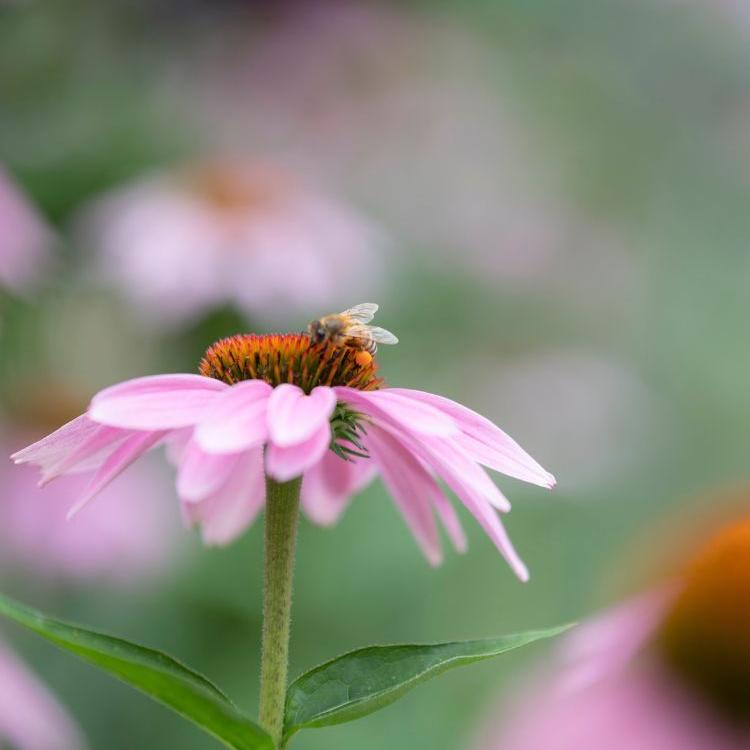Can you imagine life without some of your favorite foods? Pollinators are integral to the growth of 75 to 95% of all the Earth’s plants that need pollination to reproduce. (Ollerton et al., 2011). Without pollinators, many foods including coffee and chocolate could be in jeopardy!
Animals responsible for pollination include bees, butterflies, moths, beetles, bats, and birds. Beginning in the 19th century pollinator populations have decreased due to loss of habitat, loss of nesting locations, and increased use of pesticides (Nichols et al., 2019).
The University of Pittsburgh recognizes the importance of pollinators. As part of our Landscape & Ecology goals, we are not only working to protect existing pollinators, but to create spaces on campus where pollinator communities can grow and thrive. As part of the Pitt Sustainability Plan, we are committed to maintaining and growing tree count and canopy on campus by 2037 (compared to 2017 baseline), while improving tree health and ecosystems in Pittsburgh. Additionally, we are maintaining at least 75% of landscaped areas in alignment with Northeast Organic Farming Association Standards, ensuring a healthy environment for plants and pollinators alike.
Working Toward a Pollinator-Friendly Campus

- Our efforts to create pollinator-friendly habitats on campus are led by the Pollinator Habitat Advisory Committee.
- Pitt is a certified Bee Campus USA!
- Pollinator-friendly habitats require the use of pesticide-free materials, food sources, water, native plant species, and specific materials for nesting. Our Campus Pollinator Habitat Plan sets strict guidelines for plant selection and landscaping techniques with these requirements in mind.
- Pitt’s Sustainable Landscape Design Guidelines outline how the university maintains our campus’s landscape while upholding our commitment to stewardship.
Bee Houses
- In 2019, Pitt students designed and built seven bee houses on campus for native solitary bees, getting guidance from pollinator research conducted by Pitt Biology professor Dr. Tia-Lynn Ashman.
- The use of correct materials and proper sizing are crucial for pollinator health. Our bee houses are constructed out of wood, filled with cardboard and bamboo tubes to provide nesting space, and then placed atop 6′ posts.
- Find Pitt’s bee houses and keep an eye out for informational signs that explain the importance of pollinators around the houses.
Pollinator Gardens
Pitt is home to seven pollinator gardens.
- Butterfly Bend: Located outside Posvar Hall on the Bouquet Gardens side, Butterfly Bend was created in Spring 2025 by Bloom Service, a student group from GEOL 1333: Sustainability.
- Falk School Pollinator Garden: On Pitt’s upper campus, Falk’s garden boasts an expansive and unique design that helps our local pollinators thrive.
- Marlie Gardens: Located at the corner of O’Hara Street & Parkman, this garden was created as a visible project to bring more native vegetation to our campus.
- Posvar Pollinator Gardens
- Relearn Our Land Garden: Honors Aborigine American, Indigenous and Native cultural groups, peoples by showcasing plants showcasing plants that hold cultural significance for their medicinal or decorative properties. (Designed & planted by students in Spring 2022)
- Pollinator Garden on Schenley: Posvar’s first pollinator garden is in front of Posvar Hall on Schenley Drive; this visible garden provides shelter for pollinators with one of Pitt’s solitary bee houses.
- Pollinator Garden on Clemente: Home to a variety of different native plant species that have symbiotic relationships with the pollinators in Western Pennsylvania. (Student-designed in Spring 2020 & planted in June 2021)
- SRCC Pollinator Garden
The majority of the gardens’ landscape consists of native plant species including creeping phlox, aromatic aster, and red twig dogwood that attract various types of pollinators.
These pollinator gardens exemplify how sustainable initiatives can help improve our environment’s health and reduce resources used for maintenance.

